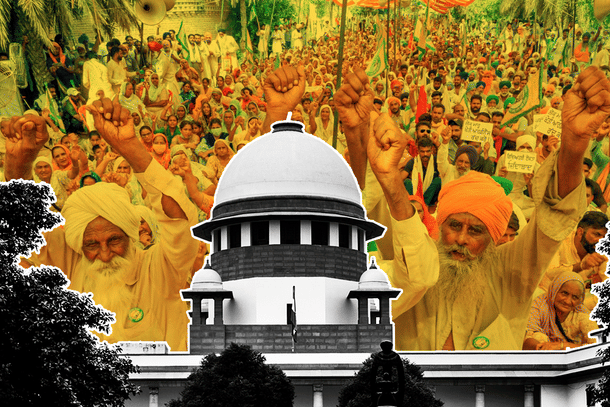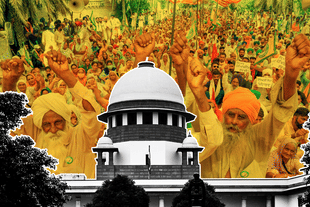Politics
NCR Pollution: Time For Judiciary To Wake Up And Smell The Coffee, Stubble, And Smog
Tushar Gupta
Nov 13, 2021, 04:21 PM | Updated 04:21 PM IST
Save & read from anywhere!
Bookmark stories for easy access on any device or the Swarajya app.


Responding to the thick blanket of smog it can see while being consciously oblivious and ignorant about the pollution across the year, the Supreme Court, responding to a plea by a 17-year-old Delhi resident, suggested that the National Capital should consider a two-day lockdown.
Disregarding the economic cost of such a move or the precedent it may set, the SC ordered the government to look beyond politics and blame games and to seek solutions that could ensure that the Air Quality Index (AQI) drops by 200-300 points in the next 2-3 days.
Perhaps, it was their eternal presence on a pedestal so high and so alienated from the common public and common scientific sense that led to the judicial overlords believing that the AQI dip was as easy to achieve as a dip in the cryptomarkets.
In their activism, this is simply another instance in a long string of mistakes that the Supreme Court has made in understanding the seasonal smog problem in NCR. The first and obvious mistake was when the Supreme Court boiled down the entire problem of smog to firecrackers during Diwali.
Choosing not to factor in the smog from the regional states of Punjab, Haryana, and Uttar Pradesh, and the wind movement, the SC attributed the smog to firecrackers.
This resulted in an entire industry being on the brink of being wiped out, local economic costs for traders in New Delhi and surrounding areas where firecracker sales worth crores of rupees happened each year, and of course, the incorrect precedent it set. More about it here.
The second mistake the SC made while pursuing judicial activism was narrowing down the entire pollution problem of NCR to the few weeks of smog between October and December.
As has been the case with the media, policymakers, and other observers, the visible smog has been mistaken as the sole testament to the pollution in Delhi. However, that is not the case.
In 2016, IIT-Kanpur conducted a detailed study of the cause of pollution in Delhi. The report was then submitted to the Delhi government and Delhi Pollution Control Committee. While citing numerous reasons for pollution in the region, the report had no mention of firecrackers.
Road dust, industrial stack, vehicular movement, concrete batching, hotels and restaurants were cited as leading causes of pollution.
For the duration between 2010 and 2015, across 1,891 days, the levels of particulate matter (PM) 2.5 were hazardous for eight Diwali days and very unhealthy for two days.
These days included the day of Diwali and the following day. Interestingly, for the same duration, there were 469 days of very unhealthy levels and 154 days of hazardous levels. Additionally, there were 632 days of unhealthy PM 2.5 levels.
Thus, for 2 out of 3 days in Delhi, across those five years, the air quality was unhealthy or worse, and this was six years ago. Since then, pollution has only grown. More about it here.
The third mistake the Supreme Court made was with the three farm laws. Today, the Supreme Court demanded an answer from the government as to why there was no incentive for the farmers to burn stubble or why more machines could not be made available to them to dispose off the stubble or why could not the government buy off the stubble if there was no other option for the farmers but to burn it.
However, the same Supreme Court wanted the protesting farmers, also protesting for their right to burn stubble, to have a free hand. Disregarding the economics of agriculture, the policies guarding the agri-market in India, the apex court confused the representation of the protesting farmers from Punjab for that of entire India and announced the stalling of farm laws implementation.
Today, the court wants to blame the government for the smog while choosing not to introspect how private sector participation could create an economy around stubble burning.
Another mistake the court has been making, one it made today as well, is believing that the smog exists only in the backyards of their government-allotted bungalows.
A drive across the Grand Trunk Road from Delhi to Amritsar, covering major parts of Haryana and Punjab will be enough for the judges to realise their folly, for the thick blanket of smog has engulfed the region north of Delhi as well.
Yet, the Supreme Court today, along with the Solicitor General, chose not to blame the farmers for the smog for reasons best known to them. Call it the convenience of politics or the laziness of policymaking, but for long, both the state governments and the judiciary have failed to address the largest elephant in the room — stubble burning.
If one looks at the data for the six weeks preceding Diwali, there is a sharp increase in the instances of stubble burning, peaking in the final week. Check out the fire maps here.
Complemented by the movement of wind in the south-east direction from Punjab, the resultant smoke from the stubble burning ends up choking the city of Delhi.
Especially on the festive days of Dussehra and Diwali, the stubble burning instances peak, and yet, the judiciary chooses not to factor that in.
Finally, the Supreme Court cannot play both sides. They cannot constrain the government on laws that usher privatisation, modern technologies, and improvement in processes like stubble burning, and then complain about the smog.
It would not be incorrect to state that the apex court suffers from the Robert Clive syndrome. Clive, the first British governor of the Bengal Presidency, and known for setting the foundation of the British Empire in India along with Warren Hastings, ran the dual-system of government in Bengal, Bihar and Orissa.
What was hence witnessed in Bengal was a dual system of government where the English had all the authority but no responsibility. In the Bengal famine of 1770, the failure of the dual government came to light.
Though it was abolished in 1772 by Clive’s successor, this system caused damage to both the natives and the company.
While our Supreme Court cannot be compared to the administrative setup of Robert Clive, its selective action and inaction when it comes to pollution and smog and today’s two-day lockdown suggestion warrant the question of authority being exercised without any responsibility and understanding.
Tushar is a senior-sub-editor at Swarajya. He tweets at @Tushar15_





